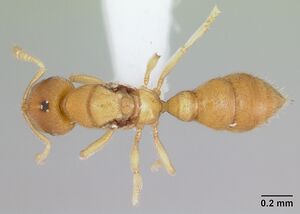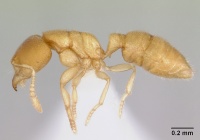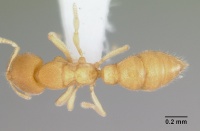Prionopelta concenta
| Prionopelta concenta | |
|---|---|

| |
| Scientific classification | |
| Kingdom: | Animalia |
| Phylum: | Arthropoda |
| Class: | Insecta |
| Order: | Hymenoptera |
| Family: | Formicidae |
| Subfamily: | Amblyoponinae |
| Tribe: | Amblyoponini |
| Genus: | Prionopelta |
| Species: | P. concenta |
| Binomial name | |
| Prionopelta concenta (Brown, 1974) | |
Brown (1974) speculated, based on morphology and placement in the Amblyoponinae, that this ant is a predator of some member of the arthropodan forest-floor microgenton. Collections have been made from soil under a clove tree, sifted litter of rotten wood and leaf mold, and soil-and-litter berlesate in forest.
Identification
Brown (1974) - Prionopelta concenta differs sharply from other Amblyoponinae, in the form of the mandibles. The 9-merous antennae are also unique, although Fulakora degenerata has only 7 segments in the antennae. The strongly constricted worker trunk, sharply marginate anterior pronotal border, and spurless middle and hind legs are also distinctive characters, not found in this combination in other Amblyoponines. The name refers to the mixture of characters of Amblyopone (now Amblyopone and Stigmatomma) and Typhlomyrmex; the shape of the mandibles and the overall habitus are at first glance like those of the neotropical genus Typhlomyrmex.
Distribution
Known from Gabon and Zanzibar Island (Tanzania).
Latitudinal Distribution Pattern
Latitudinal Range: 6.216667° to 6.216667°.
| North Temperate |
North Subtropical |
Tropical | South Subtropical |
South Temperate |
- Source: AntMaps
Distribution based on Regional Taxon Lists
Afrotropical Region: Gabon (type locality), United Republic of Tanzania.
Distribution based on AntMaps
Distribution based on AntWeb specimens
Check data from AntWeb
Countries Occupied
| Number of countries occupied by this species based on AntWiki Regional Taxon Lists. In general, fewer countries occupied indicates a narrower range, while more countries indicates a more widespread species. |

|
Estimated Abundance
| Relative abundance based on number of AntMaps records per species (this species within the purple bar). Fewer records (to the left) indicates a less abundant/encountered species while more records (to the right) indicates more abundant/encountered species. |

|
Biology
Castes
Males are unknown.
Worker
Images from AntWeb
  
| |
| Worker. Specimen code casent0004306. Photographer April Nobile, uploaded by California Academy of Sciences. | Owned by CAS, San Francisco, CA, USA. |
Queen
Images from AntWeb
   
| |
| Queen (alate/dealate). Specimen code casent0102175. Photographer April Nobile, uploaded by California Academy of Sciences. | Owned by NHMUK, London, UK. |
   
| |
| Queen (alate/dealate). Specimen code casent0004307. Photographer April Nobile, uploaded by California Academy of Sciences. | Owned by CAS, San Francisco, CA, USA. |
Nomenclature
The following information is derived from Barry Bolton's Online Catalogue of the Ants of the World.
- concenta. Concoctio concenta Brown, 1974d: 30, figs. 1-5 (w.q.) GABON.
- Type-material: holotype worker, 2 paratype workers, 1 paratype queen.
- Type-locality: holotype Gabon: Plateau d’Ipassa, Makokou, 1966, berlesate (J.A. Barra); paratypes: Tanzania: Zanzibar I., 1949, in soil (R.J. Robb).
- Type-depositories: MCZC (holotype); BMNH (paratypes).
- Combination in Prionopelta: Ward & Fisher, 2016: 691.
- Status as species: Bolton, 1995b: 146.
- Distribution; Cameroon, Gabon, Tanzania.
Unless otherwise noted the text for the remainder of this section is reported from the publication that includes the original description.
Description
Worker
Holotype: TL 2.2, HL 0.44, HW 0.40 (CI 91), ML 0.11, scape L 0.27, WL 0.62 mm. Generic characters for Concoctio given on Pilot Register of Zoology Card No. 29. Details of body form, sculpture and pilosity shown on this card in figures overleaf; see also habitus figure on Card No. 29. The apparent bicolorous condition in the figures, with trunk darker than head, petiole and gaster, is due to differences in the electron-optical properties of these parts as coated with carbon and gold-palladium.
Of characters not well shown in the figures, but reconstructed from high-magnification scanning electron microscope views, the rounded free lobe of the clypeus bears 5 stumpy teeth shaped like short-toed socks with the toes pointed laterad; median tooth with toe pointed to insect's left. Antennal scapes barely fail to reach posterior border of head when held straight back in full-face view. Legs with fine, only moderately abundant, appressed to decumbent pubescence. Color before coating uniform, light, slightly tawny yellow.
Paratypes (2): TL 2.1-2.2, HL 0.42 (both), HW 0.37-0.38 (CI 88-90), ML 0.10 (both), scape L 0.29 (both), WL 0.65-0.67 mm. The 2 para type workers differ from the holotype in their slightly smaller heads and longer scapes and trunks; scapes just reach posterior border of head in full-face view when held straight back. Also, the paratypes have the posterolateral angles of the petiolar node produced downward and backward toward the anterior face of the gaster. These cornuae are only suggested in the holotype. Otherwise, the specimens are similar to the holotype, but the anterior clypeal border could not be clearly seen in the paratypes.
Queen
dealate: TL 2.3, HL 0.43, HW 0.38 (CI 89), ML 0.11, scape L 0.31, WL 0.76 mm. Basic differences from worker cited on Card No. 29. Like the para type workers, with which it was originally collected, but head with more nearly straight sides; compound eyes feebly convex, with more or less 50 facets. Ocelli distinct, the triangle astride a dark median pigment blotch. Color and pilosity as in worker.
Type Material
Holotype (Museum of Comparative Zoology) taken from a soil-and-litter berlesate in forest on the Plateau d'Ipassa, Makokou, Gabon, by M. J. A. Barra of the University of Strasbourg during 1966; M. Barra has my thanks for the interesting material sent from this locality. The 2 worker and one queen paratypes (The Natural History Museum) were taken on Zanzibar Island in soil under a clove tree by R. I. (or R. J.) Robb during 1949, and were sent for my study by Mr. Barry Bolton, to whom I am grateful for the opportunity.
References
- Brown, W. L., Jr. 1974d. Concoctio genus nov. Pilot Regist. Zool. Card No. 29.
- Brown, W. L., Jr. 1974e. Concoctio concenta species nov. Pilot Regist. Zool. Card No. 30. (page 30, figs. 1-5 worker, queen described)
- Cantone S. 2018. Winged Ants, The queen. Dichotomous key to genera of winged female ants in the World. The Wings of Ants: morphological and systematic relationships (self-published).
- Hamer, M.T., Pierce, M.P., Guénard, B. 2023. The Amblyoponinae (Formicidae) of Hong Kong. Asian Myrmecology 16, e016005 (doi:10.20362/am.016005).
- Richter, A., Boudinot, B.E., Hita Garcia, F., Billen, J., Economo, E.P., Beutel, R.G. 2023. Wonderfully weird: the head anatomy of the armadillo ant, Tatuidris tatusia (Hymenoptera: Formicidae: Agroecomyrmecinae), with evolutionary implications. Myrmecological News 33: 35-75 (doi:10.25849/MYRMECOL.NEWS_033:035).
- Ward, P.S. & Fisher, B.L. 2016. Tales of dracula ants: the evolutionary history of the ant subfamily Amblyoponinae (Hymenoptera: Formicidae). Systematic Entomology, 41, 683–693 (doi:10.1111/syen.12186).
References based on Global Ant Biodiversity Informatics
- Brown W. L. J. 1974. Concoctio concenta species nov. Pilot Register of Zoology. Card No. 30: 1-2.
- Yeo K., T. Delsinne, S. Komate, L. L. Alonso, D. Aidara, and C. Peeters. 2016. Diversity and distribution of ant assemblages above and below ground in a West African forest–savannah mosaic (Lamto, Cote d’Ivoire). Insectes Sociaux DOI 10.1007/s00040-016-0527-6


